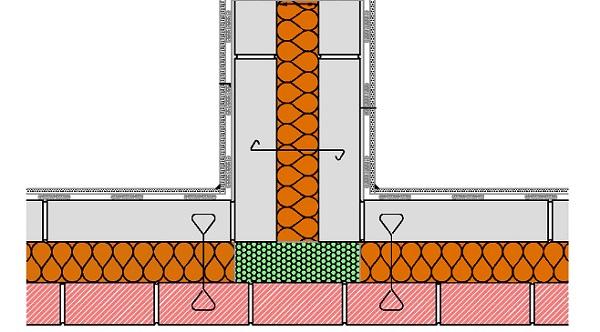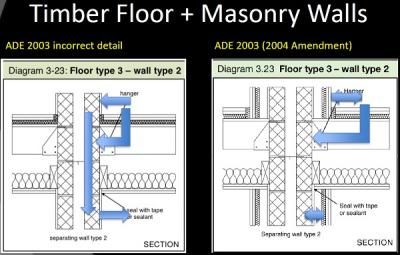How to comply with Building Regulations Part E: Design and specification key to noise problems
New dwellings that fail the acoustic test can costs many thousands of pounds to correct. So getting the design and specification right before construction is really sensible.
Sound is effectively an audible vibration, and when a sound wave hits a surface some of its energy will be reflected and some absorbed. Understanding how sound vibrations are transmitted in buildings has been instrumental in reducing complaints of unwanted noise transfer in dwellings.
Approved Document E for England and Wales provides guidance on the minimum standards for the sound insulation that separating walls and floors offer between dwellings, and also for internal walls and floors separating rooms within dwellings. It sets similar standards for other types of residential rooms such as hotel rooms.
Separating walls, floors and ceilings
The legislation is concerned with protecting residents from nuisance noise in attached dwellings and within the dwelling itself and so it requires separating walls and floors to be built in order to provide specific levels of protection. Planning policy documents (such as the National Planning Policy Framework) should be consulted when it comes to protecting dwellings from external noise sources, such as road or air traffic.
The passage of sound in a building can be controlled through the design of wall and floor constructions, which will absorb sound. A construction element’s ability to resist the passage of airborne sound energy is largely determined by the following factors:
- The sound absorbency of any cavities in the construction
- The structural isolation between the two outer surfaces
- The mass of the structure
- The air tightness of the construction
Acoustic absorption
Absorbing airborne sound in the cavity and reducing reverberation is vital and glass mineral wool insulation offers good acoustic absorption performance. Its use in carefully specified constructions with good detailing contributes significantly towards the requirements stipulated across the building regulations.
In partitions, glass mineral wool complements the plasterboard linings by absorbing airborne sound in the cavity and reducing reverberation. It is particularly effective at preventing the hollow sound that can occur in partitions with unfilled cavities.
Impact noise presents a different problem and requires different solutions. Impact noise is created by knocking sounds or walking on party floors (high heels on laminate are particularly guilty!) and can be controlled through structural isolation such as adding a resilient mineral wool or rubber layer between the floor deck and the floor structure.
When building new party walls and floors it's usually necessary to have them tested at completion by a qualified acoustician. This is when the design, detailing and construction quality is really found out.
The consequences of failing a sound test can be very costly in terms of time and money, and therefore we would always recommend that the design and construction is strictly in accordance with the details in Approved Document E or with a manufacturer’s specified solution.
Have your project tested by LABC Acoustics. Remember, with soundproofing the devil is in the detail!
See what services LABC Acoustics can provide for you
If you liked this article you might find these links useful:
Please Note: Every care was taken to ensure the information was correct at the time of publication. Any written guidance provided does not replace the user’s professional judgement. It is the responsibility of the dutyholder or person carrying out the work to ensure compliance with relevant building regulations or applicable technical standards.
This article was updated on August 2024
Sign up to the building bulletin newsletter
Over 48,000 construction professionals have already signed up for the LABC Building Bulletin.
Join them and receive useful tips, practical technical information and industry news by email once every 6 weeks.
Subscribe to the Building Bulletin





Comments
Reply to: Transmission of vibrations from washing machine
Submitted 5 years 9 months ago
If it's a new apartment within an older building then the construction to provide reasonable sound resistance should be in accordance with the current requirements within the Building Regulations (for flats formed by a material change of use).
There is also a requirement that walls/floors between flats have a pre-completion test undertaken. Details of this are explained in Approved Document E which is free to download from our website. You may wish to check these details with your legal advisor who completed the recent property transaction. Hope that helps.
Regards,
John, LABC
Converted flats - not convinced
Submitted 5 years 9 months ago
I moved into a block of 8 flats and I am not convinced that the building passed the Section E building regulations regarding sound ( I actually know that it failed the first time)
I want someone to look into this so I can take some evidence to the property managers. Private sound testing is too expensive and Environmental health say they cannot do anything regarding the sound of slamming doors, footsteps etc
Where can I get advice from?
I asked my property managers if i could see the sound test results and was told that it protected by data protection!
I can hear so much and it is driving me crazy.
Kindest Regards
Reply to: Converted flats - not convinced
Submitted 5 years 9 months ago
For your specific case it would be best to seek advice from your local authority building control team. You can find them here: https://www.labc.co.uk/your-local-council-building-control-department — simply enter your postcode and click 'Search'.
Kind regards,
LABC
Upstairs flat floorboards
Submitted 5 years 4 months ago
Reply to: Upstairs flat floorboards
Submitted 5 years 4 months ago
It would be best to speak to your local building control team who'll be pleased to provide advice about the noise levels in your specific building. You can find your local team by entering the postcode of the flat in the 'find your council' bar at the top of our website.
Kind regards,
LABC
Impact noise from neighbors below
Submitted 5 years 4 months ago
Sound insulation is terrible, i have hear muffled talking, singing in the shower and stomping.
What are my options in getting the building tested and upgraded to Part E building regulations.
Reply to: Impact noise from neighbors below
Submitted 5 years 4 months ago
It would be best to seek advice from your local building control team who can talk to you about the sound issues you've reported. You can find your local team here: https://www.labc.co.uk/your-local-council-building-control-department — simply enter the postcode of your building and click 'Search'.
Regards,
LABC
Noise from loud fans in a hospital
Submitted 4 years 10 months ago
Reply
Submitted 4 years 10 months ago
You're right - Approved Document E relates to sound transmission between dwellings and other parts of the building, it also cover acoustics in schools too.
I can appreciate your situation and the continuous noise from the fan at the hospital must be very frustrating. You mentioned that you have already raised the issue with the hospital and they have undertaken some repair works but the problem persists.
It isn’t something your local building control service would have any jurisdiction over, however it may be something the council’s environmental health service can deal with, in respect of the noise nuisance.
I would contact them and advise them of the problem. It’s likely they will visit you and assess the situation. They may ask you to monitor the noise levels over a given period of time, in order for them to establish the extent of the problem and what, if any action can be taken.
I do hope you manage to sort this out. Sorry LABC can’t be of any more help.
Kind regards,
Richard - LABC
New build
Submitted 4 years 10 months ago
They say they will not look into it further as correct materials have been used?!
Thanks
Add new comment